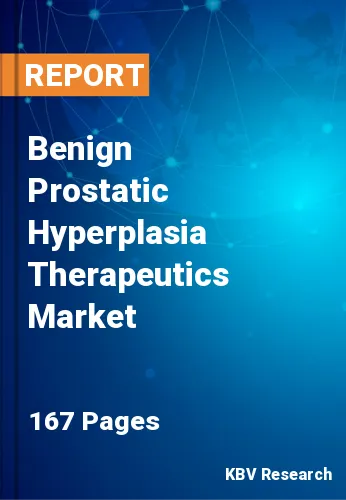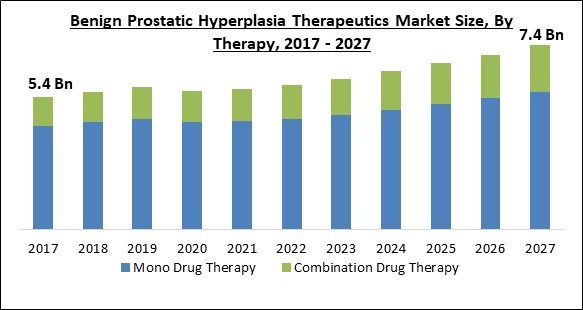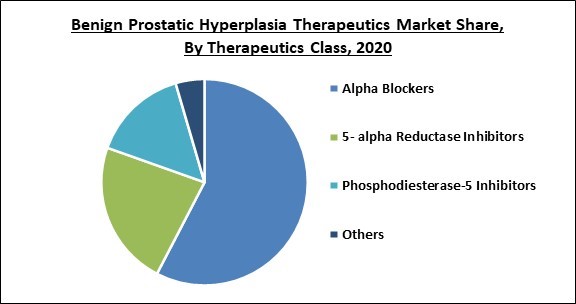
The Global Benign Prostatic Hyperplasia Therapeutics Market size is expected to reach $7.4 billion by 2027, rising at a market growth of 4.6% CAGR during the forecast period.
Benign prostatic hyperplasia (BPH) is a benign swelling of the prostate gland that is not malignant. Benign prostatic hypertrophy or benign prostatic blockages are terms used to describe this ailment. One of the most common conditions in males over the age of 50 is prostate cancer. The hyperplastic alterations in the prostate tissue that result in prostatic enlargement generate BPH symptoms.
The size of men's prostate grows larger as they grow older. As the prostate gland grows larger, it presses against and compresses the urethra and causes thickening of the bladder’s line. The obstruction increases urine outflow resistance and inhibits detrusor muscle responsiveness as a result of the obstruction. This disorder causes difficulty starting to urinate, a weak urine stream, inability to clear the urinary bladder, and increased pee frequency, which is most noticeable at night.
In men under the age of 40, signs and symptoms of prostate gland enlargement are uncommon. By the age of 60, around a third of men have moderate to severe symptoms, and by the age of 80, approximately half of men have them. Genetic background, diabetes as well as cardiovascular disease, and lifestyle are some factors that are responsible for the occurrence of benign prostate hyperplasia.
Moreover, the expiration of patents on major branded products has resulted in the development of various generic drugs, as well as collaboration among key players for the development of new BPH therapeutics for improved drug efficacy and safe therapy for prevailing drugs as well as impending new molecular entities, all of which contribute to the market's growth. The industry has been fueled further by a significant increase in healthcare expenditures around the world.

The COVID-19 pandemic caused severe losses to the world in terms of economy as well as healthcare. The pandemic caused a significant number of deaths as well as industrial closure. In addition, the COVID-19 outbreak also resulted in a negative influence on the market for treatments for benign prostatic hyperplasia. A significant number of hospitals and clinics around the world have been reconfigured to boost hospital capacity for COVID-19 patients. However, now that COVID-19 vaccines are accessible, several governments are trying to guarantee that life-saving medications and vaccines are supplied without interruption.
Elective procedures of benign pathology were recommended to be postponed until the burden on the healthcare system from COVID-19 lessened because hospitals would encounter a tremendous demand for resources to combat a likely increase in COVID-19 patients. Surgical operations such as TURP, HoLEP, ThuLEP, and PVP have to be postponed as a result.
The inconvenience that is caused by benign prostate hyperplasia keeps increasing as the age of a man increases. In addition, the immunity of aged people is comparatively much lower than young people which make them more vulnerable toward hormonal disorders. BPH is hormonally dependent on testosterone and dihydrotestosterone (DHT) production and is considered a typical aspect of male aging. By the age of 60, approximately half of men have histopathologic BPH, and by the age of 85, 90% of men have it.
With the increasing advancement and modernization, the lifestyle of people across the world is also evolving. The number of people that live a sedentary lifestyle is substantially increasing. The adoption of this lifestyle is likely to cause a significant rise in the number of people with obesity. Moreover, obesity is a major cause that facilitates the occurrence of benign prostatic hyperplasia. Due to the increased pressure on the abdominal area while seating, the prostate of a man undergoes extreme pressure and blockage in the blood vessels. This routine of people causes prostate enlargement or benign prostate hyperplasia.
While both medicines and surgery can be used to treat BPH, both have severe side effects. 5-ARIs (5-alpha reductase inhibitors), Alpha-blockers, and other medication groups are routinely used to treat BPH. Orthostatic hypotension, dizziness, retrograde ejaculation, and rhinitis are all side effects of alpha-blockers. Some of these effects are more common in the elderly people, and they can lead to serious complications such as nausea, vomiting, and diarrhea.

Based on the Therapy, the Benign prostatic hyperplasia therapeutic market is bifurcated into Mono drug therapy and Combination drug therapy. In 2020, the combination therapy recorded a substantial revenue share of the benign prostatic hyperplasia therapeutics market. The increased growth of this segment is attributed to multiple factors such as a wider range of antibiotics, colistin monotherapy having lesser effectiveness than beta-lactam monotherapy, and in vitro data demonstrating antibiotic combinations' synergy.
Based on the Therapeutic class, the Benign prostatic hyperplasia therapeutic market is segmented into Alpha blockers, 5- alpha reductase inhibitors, Phosphodiesterase-5 inhibitors, and Others. In 2020, the 5- Alpha Reductase Inhibitors segment procured a substantial revenue share of the benign prostatic hyperplasia therapeutics market. Only men with confirmed prostate enlargement should use 5-alpha reductase inhibitors. 5-alpha-reductase inhibitors are a class of medications that are used to treat benign prostatic hyperplasia (enlarged prostate) and male pattern hair loss.
| Report Attribute | Details |
|---|---|
| Market size value in 2020 | USD 5.6 Billion |
| Market size forecast in 2027 | USD 7.4 Billion |
| Base Year | 2020 |
| Historical Period | 2017 to 2019 |
| Forecast Period | 2021 to 2027 |
| Revenue Growth Rate | CAGR of 4.6% from 2021 to 2027 |
| Number of Pages | 167 |
| Number of Tables | 260 |
| Report coverage | Market Trends, Revenue Estimation and Forecast, Segmentation Analysis, Regional and Country Breakdown, Companies Strategic Developments, Company Profiling |
| Segments covered | Therapy, Therapeutics Class, Region |
| Country scope | US, Canada, Mexico, Germany, UK, France, Russia, Spain, Italy, China, Japan, India, South Korea, Singapore, Malaysia, Brazil, Argentina, UAE, Saudi Arabia, South Africa, Nigeria |
| Growth Drivers |
|
| Restraints |
|
Based on the Region, the benign prostatic hyperplasia therapeutic market is analyzed across North America, Europe, APAC, LAMEA. In 2020, North America accounted for the largest revenue share of the benign prostatic hyperplasia therapeutics market. The increased growth of the market across this region is attributed to the robust healthcare infrastructure of the countries across the region. Countries like the US, Mexico, and Canada comprise established healthcare facilities. Moreover, the increased focus of the people toward their health is another major reason for the growth of the market across North America.
Free Valuable Insights: Global Benign Prostatic Hyperplasia Therapeutics Market size to reach USD 7.4 Billion by 2027
The market research report covers the analysis of key stake holders of the market. Key companies profiled in the report include GlaxoSmithKline PLC (GSK), Astellas Pharma, Inc., Eli Lilly and Company, Allergan PLC (AbbVie), Merck Group (Merck Sharp & Dohme Corp.), Boehringer Ingelheim International GmbH, Teva Pharmaceuticals Industries Ltd., Sanofi S.A., Pfizer, Inc., and Abbott Laboratories.
By Therapy
By Therapeutics Class
By Geography
The global benign prostatic hyperplasia therapeutics market size is expected to reach $7.4 billion by 2027.
Increasing prevalence of geriatric population are driving the market in coming years, however, side-effects post BPH medications limited the growth of the market.
GlaxoSmithKline PLC (GSK), Astellas Pharma, Inc., Eli Lilly and Company, Allergan PLC (AbbVie), Merck Group (Merck Sharp & Dohme Corp.), Boehringer Ingelheim International GmbH, Teva Pharmaceuticals Industries Ltd., Sanofi S.A., Pfizer, Inc., and Abbott Laboratories.
The Mono Drug Therapy market acquired maximum revenue share in the Global Benign Prostatic Hyperplasia Therapeutics Market by Therapy 2020, and would continue to be a dominant market till 2027.
The North America market is the fastest growing region in the Global Benign Prostatic Hyperplasia Therapeutics Market by Region 2020, thereby, achieving a market value of $3.0 billion by 2027.
Our team of dedicated experts can provide you with attractive expansion opportunities for your business.
